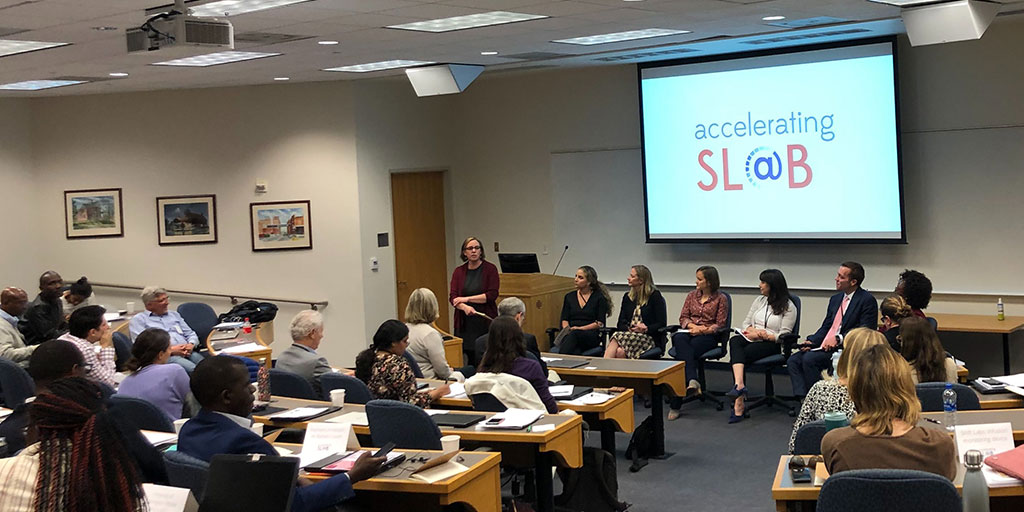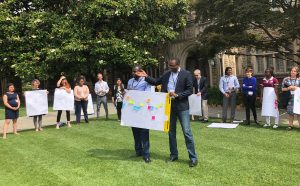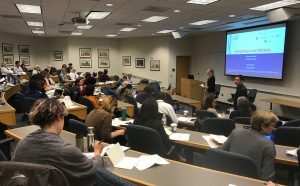
As international programs director for INMED Partnerships for Children, Kristin Callahan is no stranger to complicated issues. Her non-profit has worked in more than 100 countries, addressing a host of social problems affecting families and communities. But her group’s latest initiative—combatting neonatal jaundice in Peru—represents a departure from anything she has taken on before.
Under a grant from the Saving Lives at Birth (SL@B) Grand Challenge for Development, INMED has partnered with three medical innovators that have developed new, lower-cost technologies to screen, diagnose, and treat the condition, which worldwide leads to more than 100,000 infant deaths each year. Callahan’s group is bundling the devices in what it calls a Bilikit and is leveraging its extensive contacts in Peru’s healthcare system to introduce the package to hospitals and clinics in resource-poor areas disproportionately affected by the disease.
The project forced Callahan, a public health specialist who had never taken a formal business course, to begin thinking like an entrepreneur herself, and to challenge some of her long-held assumptions about how her group could best achieve its goals. “Nonprofits are evolving and our methods for financing are evolving,” she notes. “We are actually having to think more like a business.” Ideally, she says, her group would like to move toward a sustainable business model that would allow their programs to not always be at the mercy of roller-coaster grant cycles. It’s an adjustment that’s “forcing us to take a step back and collectively reevaluate our approach,” she acknowledges, but as she learned at a recent Accelerating Saving Lives at Birth (A-SL@B) Xcelerator workshop for Saving Lives at Birth grant recipients, having to rethink assumptions is not a sign that a venture is in trouble. Indeed, it’s often just the opposite: a key first step on the journey to success.
Workshop instructor Mark Marino, VentureWell senior program officer, compares the questioning process to the scientific method. Organizations like Callahan’s should be trying to “take each assumption and set it up as a hypothesis test,” he says. “How they would scale, the team needed, the resources needed, the receptivity of the beneficiaries, how you sustain this over time…these are things they may have started to think through but haven’t had time to really work on,” he explains. By challenging assumptions, he adds, teams can “probe all of those holes in all of those areas, to make sure they are bringing forward the best innovation possible and are well positioned to succeed in their endeavor.”
Toward that goal, Marino and the A-SL@B Xcelerator facilitators—thought leaders, mentors, and funders—presented tools, resources, and frameworks that can help startups to begin challenging assumptions in four specific areas:
- Personal journey and team capabilities,
- Market and customer fit,
- Business model and revenue plan,
- The innovation itself.
“Regardless of how difficult your problems are, if you build a solid foundation in these four areas, you’ll do much better,” he says. “If you do not have these cornerstones really understood, you’ll get lost at some point.”
Clearly, challenging assumptions is a valuable process for any venture, and one that entrepreneurs should not be afraid to embrace. As summed up by SL@B funder Janne Dingemans of Grand Challenges Canada, “The innovation journey is full of uncertainties. Ultimately, pivots need to be made, and that’s what we are encouraging.”
Personal Journey and Team Capabilities
Callahan’s journey is illustrative of how the process can play out. As an expert in nonprofit programs and their implementation, she has always been comfortable with numbers, data, and budgets, “but I can’t say that business has ever been my passion,” she acknowledges. Learning to think like an entrepreneur has proven to be very useful, she says, in part because it has given her new insights into the work of her partners—the three med-tech innovators developing neonatal jaundice devices—and how their entrepreneurial journeys might impact her team. “INMED’s struggle is that our organization can implement programs very well, but these technologies are not ours, so we are dependent on relationships with these innovators,” she explains.
The Xcelerator workshop explored team dynamics with the help of a tool called Clifton Strengths, which helps members analyze their individual capabilities. Team members fill out profiles to identify their interests and skillsets, which are then reviewed by workshop leaders. “We challenged them to consider what this data says about their team strengths,” explains A-SL@B facilitator Sarah Dunn Phillips, senior engagement manager at Duke Global Health Institute (Duke and VentureWell are partners in the A-SL@B program). “For example, we might say, your team members all seem to be people singularly devoted to science, technology, or data. To balance out the team, perhaps you also need somebody to focus on the business side?”
That kind of questioning can take a startup in new directions, notes Alana Changoor, of Grand Challenges Canada, who cited the experience of a workshop team that was in the process of hiring more staff. “They were looking mainly at just titles of positions that they needed,” she says, “but by doing the team strength assessment, they were able to hone in on specific qualities, traits, and skillsets that they would want to target instead.”
Market and Customer Fit
Callahan’s insights into market fit began with learning a new language. What the non-profit world traditionally refers to as beneficiaries became customers, she explains, while doing outreach and engaging stakeholders became identifying and reaching your market. “It’s just different terms, but there was a lot of focus on thinking in that way,” she says.

For the particular market served by INMED and other SL@B innovators, challenging assumptions can begin with the process of answering a deceptively simple question: Who exactly is my customer? “If you are trying to save lives of babies, babies are obviously not your customers,” notes workshop mentor Wilfred Njagi, co-founder and CIO of Villgro Kenya, an early-stage social enterprise incubator. “Even the baby’s mother is not your customer. So you need to understand that the target customer is the entity that will pay for the innovation: either government, ministries of health, or other NGOs. It sounds like common sense, but when you are a researcher you may not be wired to think that way.”
By understanding a product’s value proposition, Njagi explains, a startup can identify its various customer segments and the factors driving each sale. “Different customers buy for different reasons,” he says. “You might be selling the same product to government, to the private sector, to NGOs, and so you have three segments. The value proposition for each tends to be different. The NGO will say, I like using this tool because it can collect data and it will help me with my advocacy. Private sector will say, I like it because it drives down my cost. Each of these segments has unique pain points. To you, your product is one, but the offering of your product is different for each of the unique customers.”
That kind of insight offers some guidance to Callahan, who notes that her group is seeing a “very positive response” to the Bilikit in Peru, nine of which have been supplied to health facilities. “The next step is getting it to market. The government is ultimately going to be the customer doing the purchasing, unless it’s a private hospital, but the demand has to come from the mothers and the clinicians and the community health agents that are involved and using the products.”
Business Model and Revenue Plan
Of the workshop’s many tools, Callahan found the framework called the Business Model Canvas particularly helpful. Like a master plan for a startup, the canvas allows entrepreneurs to gather on one document the many factors that can determine a business’s ultimate success. “I’m very visual,” she says, “so seeing what we need to think about on one piece of paper and being able to brainstorm what goes into each of those boxes was a helpful exercise.” Even after the workshop, she’s finding the canvas—and a number of other related tools she received—useful.
“We have plans for scheduled activities, deliverables, and the impact we want to make, but the action plan asks us to think about markets and business plan development, and that’s something we really need to focus on,” she says. Similarly, the workshop’s cost analysis tool will help her compare the current standard of care for treating jaundice with her team’s approach. She’s looking forward to using the tool to “put all those figures in a spreadsheet and do the comparison.”
One area where Callahan has been challenging assumptions is in assessing her group’s long-term role as the Bilikit project scales. Since INMED is not manufacturing the actual kits, her group could eventually become just a distributor. “Do we just step out of it, and hopefully the government purchases directly from the suppliers?” Even more fundamental, Callahan has had to begin challenging assumptions about INMED’s identity as a non-profit. “We are traditionally grant-funded but we are already thinking about ways to change that, both in general and specific to this project, because it involves technologies that need to be sold to market. Again, we are still figuring it out.”
Dingemans sees all this questioning as ultimately healthy for a grant-funded startup that wants its work to be sustainable over the long term. It shows, she says, that they are “thinking about innovating in a different way, not just going from donor funding to donor funding, but thinking through that exit. That helps with integration, and other creative ways in which potential revenue streams can support elements of their invention.”
Njagi agrees, noting that INMED’s journey—with new questions arising as old ones are answered—is not unusual. “Most of the time, innovators don’t know what they don’t know yet,” he says. “So, for some of them, it’s very eye opening coming from research and trying to commercialize. It requires a mind shift.”
Improving Innovations through Peer Learning
To gain a new perspective on their innovation, as well as on their business strategy, workshop participants were given access to another valuable resource: each other. “There’s nothing better than an entrepreneur listening to another entrepreneur who has worked through the same challenges,” notes Njagi.

At breakout sessions and meetings with mentors and other entrepreneurs, the teams had a chance to share best practices, offer guidance, and, yes, help each other with challenging assumptions. Such collaboration can be particularly effective for startups working on the same problem, notes Dingemans, “both for peer learning and for taking a step back and strategically thinking through their scaling plans and the way forward for their innovation.”
With the arrival in April of the first Bilikits in Peru (and the treatment of the first neonatal jaundice patients), Callahan’s work entered a new stage. Still, her work with the A-SL@B team will continue over the next six months with ongoing consultations with mentors and peers.
Looking ahead, Njagi suggests that for INMED and all the SL@B innovators, success is ultimately more likely if they challenge one last all-too-common assumption: that they can best succeed alone. “They are fighting the same battles,” he notes. “They are driving toward the same goal—saving the lives of babies and mothers. These programs and services should be looking at how to bring synergies, how to stay engaged, how to work together.”
Accelerating SL@B, a joint program of the Duke Global Health Innovation Center and VentureWell, is funded by the generous support of the Saving Lives at Birth partners: the United States Agency for International Development (USAID), the Government of Norway, the Bill & Melinda Gates Foundation, Grand Challenges Canada, the UK Government, and the Korea International Cooperation Agency (KOICA) under USAID contract number 7200AA18C00016. This publication was reviewed by USAID.